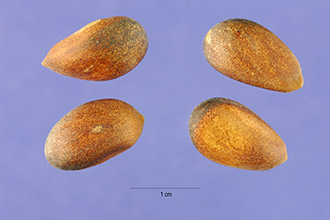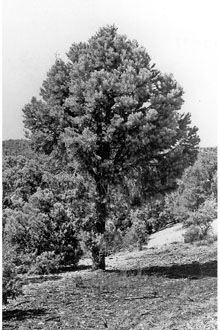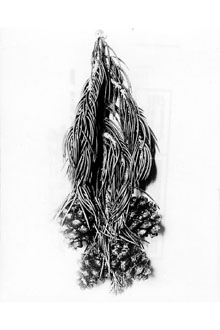Singleleaf Pinyon
Scientific Name: Pinus monophylla Torr. & Frém.

| General Information | |
|---|---|
| Usda Symbol | PIMO |
| Group | Gymnosperm |
| Life Cycle | Perennial |
| Growth Habits | Tree |
| Native Locations | PIMO |
Plant Guide
Uses
Ethnobotanic: Traditionally different tribes in California, the Great Basin, and the Southwest U.S. have utilized this tree for fuel wood and the pine nuts for food. The Washoe have made pinyon supple branches into stirring sticks for mixing pine nut soup. Pinyon pitch is melted and applied by different tribes as an outer covering for baskets to make them watertight or used to waterproof and repair pottery vessels. The tree's large, orange-red to chocolate-brown seeds have been an important food to Native Americans for millennia and are extremely important today. The cones are still gathered in the fall by tribes in California, the Great Basin and the Southwest roasted, parched, shelled, winnowed, ground into a meal, and made into nutritious pine nut soup, mush, and cakes. Another modern way to prepare the pine nuts, is to roast them in the oven in their shells, and then shelled and eaten as a snack. Since the trees produce good crops every several years, each family relies on a series of groves, rotating harvests at different groves--depending upon which grove is the most productive. Since trees can reach ages of more than 600 years, some of the tribal pinyon gathering sites have been visited for many generations. Tools and harvesting methods are purposefully designed to enhance or maintain future pinyon cone production. There are two major harvesting methods utilized today by different tribes. The first method is to use a hooked stick that brings down the flexible limbs of the tree and the green, immature cones are hand-twisted from the branches before they open and disperse their seeds. The hooked stick can also be used to snap cones off the limbs. Sometimes children climb the trunks of the trees and hand pick the cones, while others use ladders as a replacement for the hooked sticks. Harvested cones are placed in plastic buckets, a modern adaptation of the gathering basket. A second gathering method is to wait until the cones open, and then whip the trees with a pole, knocking the seeds out of the mature cones and collecting them from the ground. During this process, dead or dying branches are pruned back, a practice various tribes say is good for the trees. Alfred Brousseau © Brother Eric Vogel, St. Mary’s College @ CalPhotos Other: Early Euro-American settlers of the Great Basin logged pinyon trees, for wood, fuel for heating, cooking, and to supply steam engines. Pinyon charcoals were used to smelt the silver ores that became Nevada's number one industry in the 1860's and 70's. In the last three decades, public land agencies chained large tracts of pinyon trees and reseeded areas with non-native grasses, such as crested wheatgrass (Agropyron cristatum) to increase grasses for livestock. Other main uses of singleleaf pinyon include fence posts, Christmas trees, and edible seeds. Wildlife: Many kinds of birds and small mammals feed on the seeds including white-footed pinyon mice (Peromyscus truei), chipmunks (Tamias spp.), golden-mantled ground squirrels (Spermophilus lateralis), wood rats (Neotoma spp.), white-breasted nuthatches (Sitta carolinensis), Clark's nutcrackers (Nucifraga columbiana) and chickadees (Parus spp.). Black bears, deer, and porcupines feed on the seeds, bark, and foliage of the pinyon pine, while mountain sheep browse the foliage and twigs. The inner bark is a staple food of the mountain pine beetle, as well as the fungus causing pinyon blister rust. Even the pitch, dripping from pinecones is feasted upon by pitch midges, and is harvested for the nests of Dianthidium bees. Saw flies feed on either needles or pollen, while gall midges live in galls that occurs in the needle fascicle.
Status
Please consult the PLANTS Web site and your State Department of Natural Resources for this plant’s current status and wetland indicator values, Use soil moisture sensors to measure the soil moisture of Singleleaf Pinyon.,
Description
General: Pine Family (Pinacaeae). Singleleaf pinyon is an evergreen tree reaching heights of up to 12 meters. When young, it forms a pyramidal or rounded silhouette against the sky, while mature pinyons display a more ungroomed, irregular branching appearance. The cylindrical, bluish-gray leaves are generally one per bundle and 1 to 2 in. in length. The female cones are wind-pollinated. The subglobose cones ripen in August of the second growing season, full of 1/2-inch long, wingless seeds. Pinyon trees produce cones every three to seven years. Trees usually do not start bearing cones before they are 35 years old and do not start producing good seed crops before 100 years.
Distribution
For current distribution, please consult the Plant Profile page for this species on the PLANTS Web site. It is found in pinyon-juniper woodland, montane juniper woodlands, Jeffrey pine forests, sagebrush steppe, montane white fir forest, and subalpine woodland. In pure stands below 2800 meters in the high Sierra Nevada, the Inyo and White Mountains, the Tehachapi Mountains, and the Peninsular and Transverse Ranges of southern and eastern California. Its range extends into Arizona, New Mexico and northern Baja California in the southwest and occurs in the dry mountain ranges of Nevada, Utah, and southeastern Idaho on the east.
Establishment
Adaptation: Singleleaf pinyon often grows in association with California juniper (Juniperus californica), Sierra juniper (J. occidentalis), or Utah juniper (J. osteosperma) with an understory of shrubs and grasses such as basin sagebrush (Artemisia californica), saltbush (Atriplex spp.), rabbitbrush (Chrysothamnus spp.), antelope brush (Purshia spp.), hopsage (Grayia spinosa), Indian ricegrass (Achnatherum hymenoides), blue-bunch wheatgrass (Pseudoroegneria spicatum subsp. spicatum), and Idaho fescue (Festuca idahoensis). Planting: This slow-growing tree is rarely seen in cultivation. The seeds of pinyon need 1-3 months stratification to break winter dormancy before planting unless the maximum germinating temperature is below 73 degrees F. Low elevation/warm winters: Stratification is best done between the months of January and March. One method is to take two cups of sponge rock or perlite (expanded obsidian) and put it in a sieve and submerge it in water and let it drain. The moistened perlite is then put in a plastic Ziploc™ bag and 24 pinyon seeds (with shells removed) are placed in the perlite. Remove much of the air and zip up the bag. Place the bag on a tray and put it in the back of the refrigerator for three months. Check seeds weekly for mold and discard any moldy material. If the medium is dry, remoisten it, and make sure that the bag is completely sealed. Those that germinate should be planted with the root pointing straight down in deep tree tubes in well-drained soils until ready for out-planting. Plant 2-3 germinated seeds in soil 1/8 inch deep in each tube. Place the tubes in filtered shade or on the north or east side of a building or under a tree. Any leaf litter that falls on the tubes should be removed. The tubes need to be protected from small mammals with the construction and placement of a cage over the tubes. Water the tubes once a week or more whenever the top of the soil is dry to the touch. Pinyon pine is slow growing and should be watered and kept in tubes for one year. After that time, plant in well-drained soil to avoid the possibility of fungus and in full exposure to sun in October, ideally just before a good soaking rain. If the climate is really hot, put a shade or shingle on one side of the tree to protect it from southwest sunlight. Create a basin that is one foot wide and four or five inches deep. Make sure the downhill side of the berm is higher than the uphill side so the water will not run-off. Water deeply, but infrequently for the first two to three years after planting. If there is a problem with voles, mice, deer, rabbits, antelope, and other animals undermining the roots and girdling the seedlings precautions need to be taken to create above and below-ground wire mesh or tubes that protect the seedlings until they get fully established. Singleleaf pinyon pines are frost-resistant and extremely drought-tolerant, once established. High elevation/cold winters: The seeds from singleleaf pinyon pine can be directly planted just after harvest in tree tubes, placing 3 or 4 seeds per tube one-eighth inch deep. Set tubes outside and subjected to freezing temperatures until spring. They are then watered as soon as the ground thaws out and the soil surface becomes dry to the touch. The seedlings are watered regularly (unless rains suffice) until out-planted the following spring (one year later) as soon as the ground thaws out. Once out-planted, continue to water for the first two to three years and continue to protect the seedlings from large grazing animals and small mammals.
Management
Fire harms pinyon trees. When the tree reaches adulthood Native Americans traditionally prune back any dead wood that may accumulate. As a strategy to protect the pinyon trees from fire, some tribes in California and the Great Basin rake litter and duff from under pinenut trees and hand remove shrubs that might act as a fuel ladder during a fire. They prune back low-lying limbs under the trees that could catch fire. Historically many areas in the pinyon juniper forests that were places where people habitually camped or collected pine nuts were carefully cleaned of underbrush as part of routine and necessary maintenance. The pinyon pine engraver (Ips confusus) is a bark beetle that inhabits pinyon pine. The brown beetles bore egg galleries along the grain of the wood. Dwarf mistletoe (Arceuthobium campylopodum) taps pinyon limbs for water and nutrients, causing a hormonal imbalance, swelling in the plant, and acting as a food sump. Pinyon pine is subject to attacks by a host of other pathogens, most of which weaken but do not kill the tree. This include needlecast fungi (Bifusella pini) which inhabits the needles, pinyon bluster rust (Cronartium occidentale) which infects the living branches, and elytroderma disease (Elytroderma deformans) which upsets the hormonal balance causing bud stimulation. This leads to the production of extra branches which gives the tree a brooming effect. Brown crumbly rot (Fomitopsis pinicola), a heart rot fungus, will decimate senescent trees. It moves from the heartwood into the roots, rotting them, and the tree falls over. Cultivars, Improved and Selected Materials (and area of origin) This species is readily available from nurseries throughout its range. Contact your local Natural Resources Conservation Service (formerly Soil Conservation Service) office for more information. Look in the phone book under ”United States Government.” The Natural Resources
Conservation
Service will be listed under the subheading “Department of Agriculture.”
Plant Traits
Growth Requirements
| Temperature, Minimum (°F) | -23 |
|---|---|
| Adapted to Coarse Textured Soils | Yes |
| Adapted to Fine Textured Soils | No |
| Adapted to Medium Textured Soils | Yes |
| Anaerobic Tolerance | None |
| CaCO3 Tolerance | High |
| Cold Stratification Required | Yes |
| Drought Tolerance | High |
| Fertility Requirement | Low |
| Fire Tolerance | Low |
| Frost Free Days, Minimum | 150 |
| Hedge Tolerance | Low |
| Moisture Use | Low |
| pH, Maximum | 7.5 |
| pH, Minimum | 6.2 |
| Planting Density per Acre, Maxim | 600 |
| Planting Density per Acre, Minim | 170 |
| Precipitation, Maximum | 20 |
| Precipitation, Minimum | 11 |
| Root Depth, Minimum (inches) | 40 |
| Salinity Tolerance | None |
| Shade Tolerance | Intolerant |
Morphology/Physiology
| Bloat | None |
|---|---|
| Toxicity | Slight |
| Resprout Ability | No |
| Shape and Orientation | Rounded |
| Active Growth Period | Spring and Summer |
| C:N Ratio | High |
| Coppice Potential | No |
| Fall Conspicuous | No |
| Fire Resistant | No |
| Flower Color | Yellow |
| Flower Conspicuous | No |
| Foliage Color | Green |
| Foliage Porosity Summer | Moderate |
| Foliage Porosity Winter | Moderate |
| Foliage Texture | Medium |
| Fruit/Seed Conspicuous | No |
| Nitrogen Fixation | None |
| Low Growing Grass | No |
| Lifespan | Long |
| Leaf Retention | Yes |
| Known Allelopath | Yes |
| Height, Mature (feet) | 50.0 |
| Height at 20 Years, Maximum (fee | 20 |
| Growth Rate | Slow |
| Growth Form | Single Stem |
| Fruit/Seed Color | Brown |
Reproduction
| Vegetative Spread Rate | Slow |
|---|---|
| Small Grain | No |
| Seedling Vigor | Low |
| Seed Spread Rate | Moderate |
| Seed per Pound | 1110 |
| Fruit/Seed Persistence | No |
| Propagated by Tubers | No |
| Propagated by Sprigs | No |
| Propagated by Sod | No |
| Propagated by Seed | Yes |
| Propagated by Corm | No |
| Propagated by Cuttings | No |
| Bloom Period | Mid Spring |
| Commercial Availability | Contracting Only |
| Fruit/Seed Abundance | Medium |
| Fruit/Seed Period Begin | Summer |
| Fruit/Seed Period End | Fall |
| Propagated by Bare Root | Yes |
| Propagated by Bulb | No |
| Propagated by Container | Yes |
Suitability/Use
| Veneer Product | No |
|---|---|
| Pulpwood Product | No |
| Protein Potential | Low |
| Post Product | Yes |
| Palatable Human | Yes |
| Palatable Graze Animal | Low |
| Palatable Browse Animal | Low |
| Nursery Stock Product | Yes |
| Naval Store Product | No |
| Lumber Product | No |
| Fuelwood Product | Medium |
| Fodder Product | No |
| Christmas Tree Product | Yes |
| Berry/Nut/Seed Product | Yes |


